In January, 2020, Penobscot County was asked to refuse to consent to refugee resettlement, despite the fact that Catholic Charities Maine (CCM), the state’s only refugee resettlement agency, has never resettled refugees in Penobscot County. In the end, after receiving facts (see below) about refugee resettlement from CCM and data about the positive economic contributions of refugees from MeBIC, and community feedback supporting refugees, the Penobscot County Commissioners agreed to welcome refugees if they should ever want to live there.
Other counties have entered the debate recently, as well, with Piscataquis and Franklin County Commissioners voting not to consent to refugee resettlement. Again, CCM has never resettled refugees in those counties, nor do they have plans to do so. And refugees are free to move anywhere in the country, just as U.S. citizens can, regardless of where they are initially resettled.
Both Franklin and Piscataquis Counties have declining populations, more residents over age 65 than under age 18, unemployment under 4%, and a shrinking workforce. They should be sending messages to attract new residents, regardless of their origins. Their recent votes send a contrary message that may discourage immigrants and nonimmigrants, whether temporary seasonal or professional level workers, international students, and even U.S. born children of immigrants, from choosing to live and work in their counties.
Hancock County has been asked by county residents to affirmatively consent to refugee resettlement, should CCM ever wish to resettle refugees there, and will take the issue up on March 3rd. Franklin County will also receive more information from CCM and MeBIC about refugees and the resettlement process, and feedback on its vote not to consent, at its March 3rd meeting.
The issue was raised due to an unprecedented Executive Order (E.O.) issued by the President on September 26, 2019 purporting to give states and localities veto power over refugee resettlement. That (E.O.) was enjoined by a federal court on January 15, 2020 while its legality is challenged. Prior to that Governor Mills gave Maine’s consent to participate in refugee resettlement, as the state has done for over 40 years. Given the historic and current contributions of refugees and immigrants to Maine’s communities and economy, Governor Mills made the right choice for Maine’s future from a values and an economic perspective.
Facts about refugees:
Despite starting there lives over in the U.S. from scratch, in a relatively short period, refugees contribute more to the economy in taxes than they consume in public benefits. A draft government report found in 2017 that within ten years of arrival in the U.S., refugees contributed more in taxes than they received in benefits.[1] A 2017 National Bureau of Economic Research working paper found that within six years of arrival, refugees have higher rates of labor force participation than native U.S. citizens, even if their wages may be lower, and within twenty years of arrival, have contributed $21,000 more in tax payments than they received in public benefits.[2]
Other data indicates that refugees become entrepreneurs at higher rates than U.S. citizens and even than other immigrants, and in 2015, refugee-owned businesses generated over $4.6 billion in business income nationwide.[3] That year refugees also paid nearly $21 billion in federal, state, and local taxes, and had over $56 billion in purchasing power. More refugees are in their prime working years than the native-born population, with over 77% of them of prime working age in 2015, compared to over 49% of native U.S. citizens.[4] Data specifically for Maine’s District 2 (in which each of the counties considering the “refugee consent” sit) indicates that in 2014, more than 750 immigrants, including refugees, owned businesses, and immigrants paid more than $34 million in state and local taxes.[5]
[1] https://www.nytimes.com/interactive/2017/09/19/us/politics/document-Refugee-Report.html
[2] https://www.nber.org/papers/w23498
[3] https://research.newamericaneconomy.org/report/from-struggle-to-resilience-the-economic-impact-of-refugees-in-america
[4] Id.
[5] https://www.newamericaneconomy.org/locations/maine/maine-district-2/


